Join More Than 50,000+ Subscribers and get latest camera news and rumors
NEW CAMERA VIDEOS ON YOUTUBE
|
By admin, on November 18th, 2024
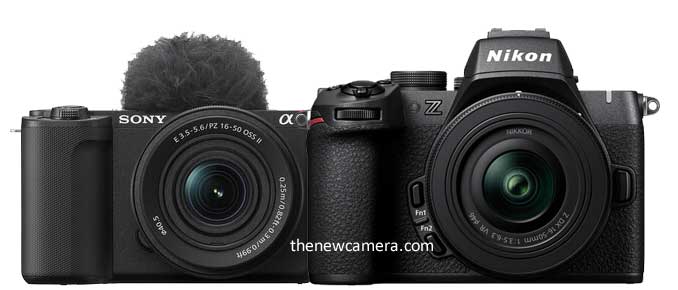
Let’s Compare the Sony ZV-E10 II and the Nikon Z50 II. The big question is, which one is better for your own personal requirements and your budget too? So, we are going to compare the major differences between the two, and you have to keep your requirements in mind. Every time we compare the major specs of the cameras, here we are also analyzing that particular spec in our conclusion and verdict part. Jump in and find out the best camera for you!
Nikon Z50 II vs Canon R10 | Nikon Z50 II vs Sony A6700
Design and Build
| Feature |
Nikon Z50 II |
Sony ZV-E10 II |
| Lens Mount |
Nikon Z |
Sony E |
| Body Material |
Magnesium Alloy |
Polycarbonate with Metal Components |
| Weight (With Battery) |
Approx. 450 g |
377 g |
| Dimensions (W x H x D) |
126.5 x 93.5 x 60 mm |
114.8 x 67.5 x 54.2 mm |
| Monitor Display |
3.2″ 1.04M-Dot Tilting Touchscreen LCD |
3.0″ 1.03M-Dot Articulating Touchscreen LCD |
| Viewfinder |
0.39″ OLED, 2.36M-Dot, 100% coverage |
No Viewfinder |
| Weather-Sealing |
Yes |
No |
| Built-In ND Filter |
No |
No |
| Hot Shoe Mount |
Yes |
Yes (Multi-Interface Shoe for Accessories) |
Design – Compact Creator vs Rugged Explore
These two cameras are completely different specifically design-wise. The Sony ZV-E10 Mark II camera does have a small hand grip for shooting occasionally, but as we know since it belongs to the SONY ZV Series has been designed for content creation and cinematography. It has an ultra-compact body with fewer controls. The camera also doesn’t have any weather sealing over it neither the EVF.
The Nikon Z50 Mark II HYBRID camera has an electronic viewfinder with 1000 nits brightness. It also has a very deep and redesigned hand grip, even better than its predecessor. At the same time, the body is weather-sealed, so you can shoot in uncontrolled light environments without any issues.
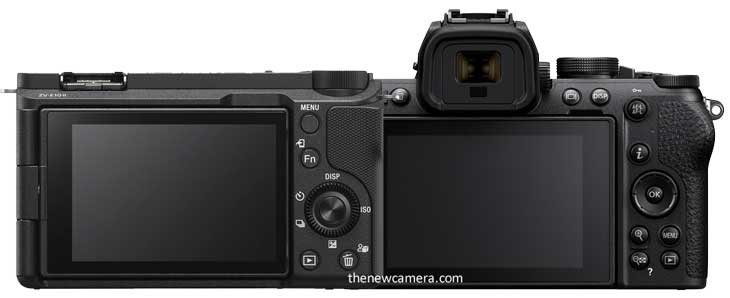
Best Camera as per Design Conclusion / Verdict
For portability, flexibility, and easier controls, the Sony ZV-E10 II leads. Again, for durability, extensive manual controls, and outdoor adventure, it is recommended to use the Nikon Z50 II camera.
Imaging Capabilities
| Feature |
Nikon Z50 II |
Sony ZV-E10 II |
| Sensor Type and Size |
APS-C CMOS, 23.5 x 15.7 mm |
APS-C CMOS, 23.3 x 15.5 mm |
| Resolution |
20.9 MP |
26 MP |
| ISO Sensitivity (Photo) |
100-51,200 (Expandable to 204,800) |
100-32,000 (Expandable to 50-102,400) |
| Continuous Shooting Speed |
11 fps 200 RAW/ 15 fps / 30 Fps Jpeg |
Up to 11 fps for 59 RAW / 1000 JPEG Frames |
| Autofocus Points (Photo) |
209 Phase-Detection Points |
759 Phase-Detection Points |
| Low-Light AF Sensitivity |
-9 EV |
-3 EV |
| Image Stabilization |
VR for Video only |
Digital + GYRO (Video Only) |
| Aspect Ratios Available |
3:2, 16:9 |
3:2, 16:9 |
| Image File Formats |
JPEG, NEF (RAW) |
JPEG, HEIF, Raw |
High Resolution vs Low Light Sensitivity
As we know, the Sony ZV-E10 II camera features a 26-megapixel CMOS sensor, while the Nikon Z50 II has a 20.9-megapixel sensor. Due to the resolution difference, the Sony ZV-E10 II camera captures more detail at the base ISO range starting from ISO 100-400, and it’s more recommended for landscape photography, portraits, and product shots where one wants to harness the maximum amount of detail possible from a camera.
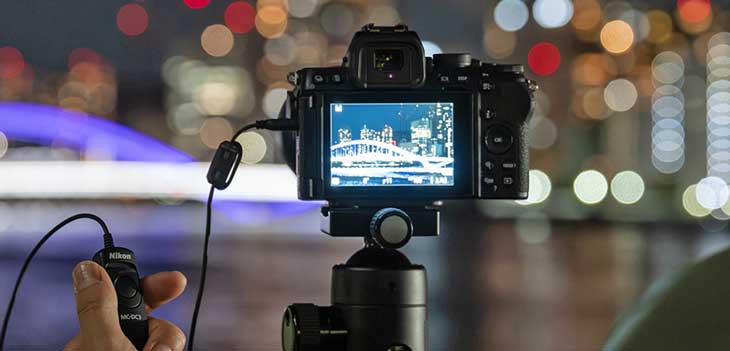
On the other hand, we have the Nikon Z50 II camera with a 20.9-megapixel sensor. Due to the lower resolution, we have large photodiodes inside this camera, which enables more incoming light to be absorbed, resulting in cleaner images at higher ISOs. For example, if you are shooting at ISO 1600 or 3200, the Z50 II camera will provide you with cleaner images compared to he compatitor.
Sensor Image Quality – Conclusion / Verdict
When shooting in uncontrolled light environments, it is highly recommended that you get the Nikon Z50 II camera, specifically when you are shooting wildlife where your subject can be at any place or time, then it’s recommended to have cameras like Z50 II that can capture better details or images at higher ISO ranges.
Autofocus: AI Precision vs Autofocus Consistency
Sony ZV-E10 II camera features 759 phase-detection autofocus points. Not only does the number of autofocus points matter, but the autofocus algorithm of the Sony ZV-E10 II camera is powered by an advanced AI AF algorithm, so it enhances the overall autofocus experience 2x better than what it was in the Sony A6400 camera.
And Nikon Z50 Mark II also arrives with an upgraded autofocus system. As per Nikon’s press text, the Z50 Mark II camera uses the same autofocus algorithm that we have seen in the Nikon Z8 camera. Having said that, it’s a major improvement in Nikon APS-C lineup, and without a doubt, you can feel it. For example, even at 30 frames per second when you are using Nikon Z50 II at C30 mode, the camera does autofocus and auto-exposure calculation in every frame. That is a clear indication of how fast the Z50 Mark II autofocus calculation has now become.
The good thing about Nikon Z50 Mark II is, apart from improved autofocus modes, the camera does autofocus sensitivity up to -9 EV, whereas in Sony it’s limited to -3 to -4 EV depending upon the type of lenses you are using in both the cameras.
30 FPS Continuous shooting speed, the Nikon Z50 II camera features continuous shooting upto 30 FPS as well as Pre-Brust modes of 0.35ses, .05 Ses, and 1.0 Sec that captures a MAX of 30 Jpegs before you hit the shutter, one of the only cameras that offer pre-burst mode in this price segment.
Best AutoFocus – Conclusion / Verdict
Now, even though the Z50 II autofocus is much improved, for action-packed VIDEOS, it is highly recommended to use the Sony ZV-E10 Mark II camera 😉 . But for shooting action-packed images at higher frame rates, Z50 is the best option where you have multiple options like shooting with a mechanical shutter or electronic, at the very same time, the camera does autofocus and auto-exposure calculation all the way, even at 30 fps. That’s the Nikon Z50 II recommended for shooting action-packed images when we have these two options in front.
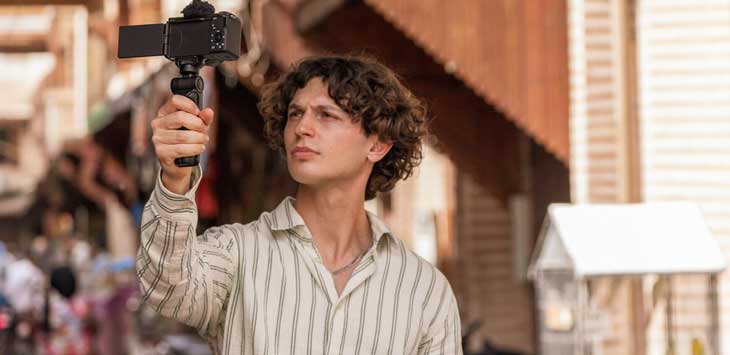
Electronic Stabilization vs Gyro
None of the cameras has Sensor-Shift IS [No Mechnical], The Sony ZV-E10 II camera uses GYRO which also includes active image stabilization. The Active IS works flawlessly but needs wide lenses to crop and apply the steb. If you have that much wider better to use GYRO. Nikon Z50 Mark II camera uses electronic stabilization in video mode [E-VR], which is of course not as good as we have in the Sony ZV-E10 II, but yeah, it is effective to some extent.
Best Camera for Handheld Shooting – Conclusion / Verdict
Since none of them have any kind of mechanical stabilization inside them, and if you talk about electronic image stabilization, then Sony excels while using the active mode as well as an option to use gyro-based image stabilization.
Video Capabilities
| Feature |
Nikon Z50 II |
Sony ZV-E10 II |
| Internal Recording Modes |
H.264/H.265 8/10-Bit |
XAVC HS/S 4:2:2 10-Bit, XAVC S 8-Bit, XAVC S-I 10-Bit |
Max 4K Res.
|
UHD 4K 60p 1.5X Crop |
UHD 4K 60p 1.04X Crop |
| High-Speed Recording |
1920 x 1080 up to 120 fps |
1080p up to 240 fps |
| Recording Limit |
Approx. 121 mins |
No recording limit |
| Gamma Profiles |
N Log |
S-Cinetone, S-Log3 |
Luts
|
RED-Luts |
Picture Profiles |
| Built-In Microphone |
Mono |
Stereo |
| Audio Inputs and Outputs |
Microphone and Headphone |
Microphone input, Headphone output |
| Focus Points (Video) |
209 Phase-Detection Points |
495 Phase-Detection Points |
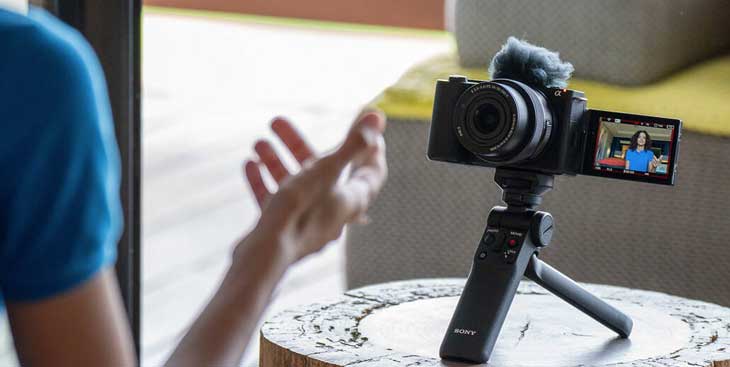
Color Science: Grading Playground vs. Ready-to-Use Output
Sony ZV-E10 II camera is built for cinematic video and content creation purposes. It supports 4K video recording up to 60 frames per second with a negligible crop of 1.03x. At the same time, you can record your videos in 10-bit 4:2:2 internally. It also supports professional-grade S-Log3 and S-Cinetone, which professionals generally prefer to use.
The Sony ZV-E10 II camera also features a gyro-based image stabilization system backed by Active Mode, so depending on the type of lens you have, you can utilize any of these image stabilization methods.
Yes, we do have Product Showcase Mode and Active Framing, ideal for content creators shooting solo content. Additionally, the battery life and ultra-compact body make it highly portable.

Nikon Z50 II camera features 4K 60p recording with a 1.5x crop, which may or may not suit many professionals out there. However, the good news is that the Nikon Z50 II features natural color science, inspired by RED camera makers. The RED-like color science is now available in the Z50 II camera. Additionally, the camera also supports waveform function, which professionals will love.
If you make talking-head videos while sitting in your room, you can use the newly developed Product Review Mode or Product Showcase Mode of the Nikon camera. However, the image stabilization is not as effective as that of Sony’s.
If you’re a professional cinematographer, short filmmaker, or story trailer, you’ll appreciate the RED-like color science present in the Z50 II. Despite the crop in 4K 60p, if you’re okay with it, you’ll benefit from waveform support, which is highly essential for professional storytelling.
The Sony ZV-E10 II camera, designed for video creation, includes all the bells and whistles you’d wish for in a professional video camera.
Power and Connectivity
| Feature |
Nikon Z50 II |
Sony ZV-E10 II |
| Battery Type |
EN-EL25a, Approx. 320 Shots |
NP-FZ100, Approx. 610 Shots |
| USB-C for Power/Charging |
Yes |
Yes |
| Media/Memory Card Slot |
Single SD Slot (UHS-II) |
Single SD Slot (UHS-II) |
| Wireless |
Wi-Fi, Bluetooth |
Wi-Fi (2.4/5 GHz), Bluetooth 4.2 |
| Mobile App Compatibility |
SnapBridge |
Creators’ App (Android & iOS) |
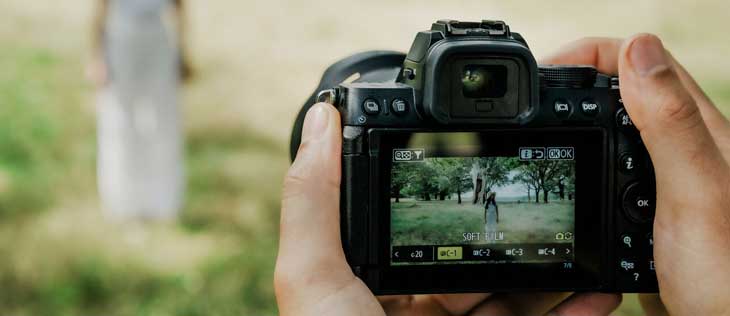
Nikon Z50 Mark II: Weather-Sealed BODY and Low-Light Sensor
In conclusion, the Sony ZV-E10 II camera and the Nikon Z50 Mark 2 camera are made for different types of users. If you look carefully, without a doubt, the Nikon Z50 Mark 2 camera has been made with a deep hand grip, EVF and a rugged body. The camera also features excellent low-light performance with its 20.9 MP sensor and, without the option of an optical low-pass filter, it captures decent images at base ISO. This makes it an ideal camera for wildlife photography, event photography, and even travel photography where you have a completely uncontrolled set of environments and lights.
Sony ZV-E10 II: Best for HANDHELD Content Creators
The Sony ZV-E10 II camera is a content creator’s powerhouse that offers 4K 60 FPS recording, which is almost uncropped since it has only a 1.03x crop, which is unnoticeable. You can record 10-bit videos internally, powered by S-Log3 and S-Cinetone. One of the best things about the Sony camera is that you are getting active image stabilization backed by gyro-based stabilization, ideal for those who love to shoot their content on the go. It will provide completely stable, high-quality footage. Additional features include product showcase mode, active framing, and a three-capsule microphone to record high-quality audio directly in the camera. More or less, it is highly recommended for content creators.
Sony ZV-E10 II: For Photography?
Yes, you can occasionally use the ZV-E10 II camera for photography purposes to get a resolution advantage, but it is highly recommended that you use this camera with proper lighting conditions to extract the maximum amount of detail possible.
Nikon Z50 Mark II: Cinematographers and StoryTellers
The Nikon Z50 Mark II camera does have some exceptional advantages in video recording modes that should not be overlooked. It captures clean and noise-free videos at higher ISO levels and has been inspired by RED cinema profiles. Moreover, it also features waveform capability with a weather-sealed body. So if you are a short film storyteller or beginner cinematographer, you should consider these factors before getting your first camera for professional cinematography purposes.
Sony ZV-E10 II from B&H Store | Amazon.com
Sony ZV-E10 II Recommended for:
- Casual Clicks
- Wedding Video
- Vlogging / YouTube Content Creation
- Solo Content Creation (Active Framing & Product Showcase Mode)
- Cinematic SOLO Videography (with S-Log3 & S-Cinetone)
- Casual Travel Videography
- Compact, On-the-Go Shooting
Get a Nikon Z50 Mark II camera from the B&H Store | Amazon.com
Nikon Z50 II Recommended for:
- Low-Light Photography
- Wildlife Photography
- Wedding Photography
- Event Photography (due to clean high ISO performance)
- Documentary Videography
- Cinematic Filmmaking (low light, RED-inspired color science)
- Rugged Outdoor Photography (weather-sealed body)
- Travel Photography in Challenging Environments
- High ISO Videography
- Professional Video Shoots (Waveform & RED LUTs)
Support us – Use or affiliate link Amazon.com | B&H Store for the next purchase u make – it helps us 🙂
Follow us on our social pages FACEBOOK | TWITTER | INSTAGRAM to get live Camera News +
By admin, on October 17th, 2024
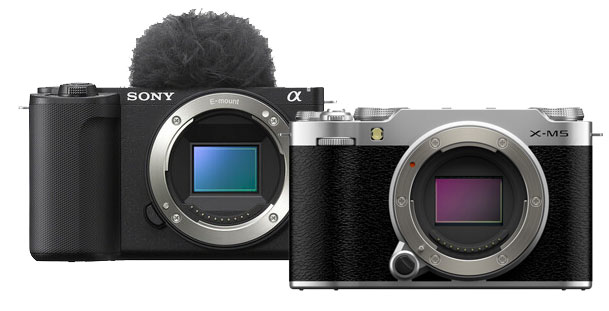
Compare the Sony ZV-E10 II camera against the recently announced Fuji X-M5. We will be comparing the 10 major differences between the two. Not only that, but these are the differences we have sorted out to make it a bit easier to understand instead of putting all comparisons in front of you in a single table. So we have distributed them into 10 different types of tables, so let’s begin.
See more comparisons – Fuji X-M5 vs Sony A6700
1. Camera Design Comparison
| Feature |
Sony ZV-E10 II |
Fuji X-M5 |
| Lens Mount |
Sony E |
FUJIFILM X |
| Built-In Flash |
No |
No |
| Display |
3″ Articulating Touchscreen LCD |
3″ 3-Way Tilting Touchscreen LCD |
| Body Material |
Plastic Body |
Magnesium Alloy |
In the first section, where we compare the camera design and all the details, you can see that the Fuji X-M5 is slightly smaller and a bit lighter than the Sony ZV-E10 II. The biggest advantage I see with the X-M5 is the weather-sealed design and a more durable body
2. Body Weight and Dimensions Comparison
| Feature |
Sony ZV-E10 II |
Fuji X-M5 |
| Body Weight (with battery & media) |
377 g |
355 g |
| Dimensions (W x H x D) |
114.8 x 67.5 x 54.2 mm |
111.9 x 66.6 x 38 mm |
3. Ports Comparison
| Feature |
Sony ZV-E10 II |
Fuji X-M5 |
| HDMI Output |
Micro-HDMI |
Micro-HDMI |
| Audio Input |
1x 3.5mm Microphone Input |
1x 3.5mm Microphone Input |
| Audio Output |
1x 3.5mm Headphone Output |
1x 3.5mm Headphone Output |
| USB-C |
USB 3.2 Gen 1 (Data & Power) |
USB-C (Data) |
The next is the ports comparison. More or less, both have similar kinds of ports—micro HDMI input, headphone, and output port, so connectivity-wise both are quite similar to each other.
4. Camera Sensor Comparison
| Feature |
Sony ZV-E10 II |
Fuji X-M5 |
| Sensor Size |
APS-C (23.3 x 15.5 mm) |
APS-C (23.5 x 15.6 mm) |
| Effective Resolution |
26 MP |
26.1 MP |
| Sensor Crop Factor |
1.5x |
1.5x |
Let’s compare the internal core specifications of the cameras. We have the 26 MP X-Trans sensor on the Fuji side, while the Sony has a 24 MP Bayer pattern BSI CMOS sensor. More or less, we will get similar image quality from both cameras.
No, neither of the cameras has any mechanical stabilization inside them for stills, so you have to be careful while using these cameras.

5. Autofocus Comparison
| Feature |
Sony ZV-E10 II |
Fuji X-M5 |
| Autofocus Points (Photo) |
759 Phase Detection |
425 Phase Detection |
| Autofocus Sensitivity |
-3 to +20 EV |
-7 to +7 EV |
| Autofocus Modes |
Auto, Continuous, Single, Manual |
Continuous, Single, Manual |
The autofocus system of both cameras is super awesome. Still, again, since Sony and Canon are leading in autofocus tracking, as well as if you compare the number of phase-detect autofocus points, the Sony ZV-E10 II has 759 AF points, while the X-M5 remains limited to 425. So, more or less, the tracking performance coming straight out of the Sony camera will be more usable and reliable compared to the Fuji X-M5.
6. Image Stabilization Comparison
| Feature |
Sony ZV-E10 II |
Fuji X-M5 |
| Image Stabilization (Photo) |
No |
No |
| Image Stabilization (Video) |
Digital, Active IS, Gyro |
Digital IS |
On the other side, we have better autofocus sensitivity in the Fuji X-M5, which means the ability to lock focus in backlit situations is better with the X-M5. But again, AF sensitivity doesn’t help much with tracking performance. So both are completely different in terms of tracking and sensitivity. Generally, we rely more on tracking performance rather than sensitivity.
7. Continuous Shooting Speed Comparison
| Feature |
Sony ZV-E10 II |
Fuji X-M5 |
| Max Continuous Shooting |
11 fps (Photo) |
30 fps (Photo with electronic shutter) |
| Max Frames in Burst |
59 (RAW) / 1000 (JPEG) |
23 (RAW) / 128 (JPEG) |
The X-M5 offers 30 fps continuous shooting with the electronic shutter but with some crop. If I select the uncropped mode, the speed drops to 20 fps, which is still better than the Sony ZV-E10 II’s 11 fps continuous shooting mode.
8. Video Resolution Comparison
| Feature |
Sony ZV-E10 II |
Fuji X-M5 |
| 4K Video |
3840 x 2160 at 60 fps |
6240 x 4160 at 30 fps |
| Full HD Video |
1920 x 1080 at 120 fps |
1920 x 1080 at 240 fps |
| Video Bit Depth |
10-Bit |
10-Bit |
Before you come to a decision that you are going to buy a camera with 6.2K resolution, you must first look towards your own personal requirements. If your personal requirements fulfill with 4K recording up to 60 frames per second, then without a doubt, a camera with more than 60fps mode is enough for you. But if you are a short filmmaker or someone who likes to get an open gate video in F-Log2 mode and then later on edit in your editing software, then you should buy the Fuji X-M5 camera. Otherwise, if you are a YouTube content creator or create Instagram Reels, then there is no need to buy a camera with 6K open gate recording.
To be very clear, the Fuji X-M5 does not have the same autofocus tracking performance as the Sony ZV-E10 II.
9. Codecs and Bitrates Comparison
| Feature |
Sony ZV-E10 II |
Fuji X-M5 |
| Codecs |
H.264, H.265, XAVC S |
H.264, H.265, AVC-LongG |
| Bitrates |
100 to 600 Mb/s |
8 to 200 Mb/s |
10. Extra Video Features Comparison
| Feature |
Sony ZV-E10 II |
Fuji X-M5 |
| Log Profile |
Sony S-Log3, S-Cinetone |
FUJIFILM F-Log, F-Log 2 |
| Slow/Fast Motion |
Yes |
Yes |
| Recording Limit |
No Limit |
50 Minutes (4K) (Unlimited in 4k LP low Quality) |
Sony ZV-E10 Mark II camera, despite the fact that the camera doesn’t have a 6.2K open gate recording, gives you a bitrate option of 600 Mbps, whereas a Fuji X-M5 camera with 6.2K open gate recording limits the bitrate to 200 Mbps. So there is a very simple math calculation: more bitrate means more color coming into your footage.
Another big noticeable difference before we jump to the limitations we have to face with each of the cameras is that the Fuji X-M5 in 4K has a recording limit of 50 minutes. Now, the 50-minute recording can only be extended when you are using an LP mode in 4K, which degrades the quality of 4K recording, but it allows you to record for more than an hour. So you have to decide that if you are into podcasting, then select your camera wisely.
10. Video Recording Time Limit and Known Limitations
| Feature/ Limitation |
Sony ZV-E10 II |
Fuji X-M5 |
| 4K Video Recording Time Limit |
No official time limit (subject to thermal control) |
No official time limit (4K) (4k Lp low-quality unlimited recording) |
| Full HD Video Time Limit |
No official time limit |
No official time limit |
| Thermal Management |
Auto shut-off based on temperature settings (standard or high) |
Thermal control to avoid overheating (cut-off) |
| Battery Life (Video) |
Approx. 80 minutes (continuous recording) |
Approx. 60 minutes (4K) |
| Overheating Issues |
Rare in typical conditions |
May occur during extended 4K recording sessions |
| Slow-Motion Recording Limit |
No official limit (depends on settings and battery life) |
Approx. 3 minutes (240 fps Full HD) |
| Continuous Autofocus in Video |
Yes, with Eye and Object Tracking |
Yes, with Eye Detection and Fast AF |
| Internal Recording Bit Depth |
10-Bit Internal recording |
10-Bit internal recording |
| External Recording |
4K 60fps via HDMI output (10-Bit) |
4K 30fps via HDMI output (10-Bit) |
| Rolling Shutter (4K) |
Moderate at 4K 30 fps |
Moderate at 4K 30 fps |
Conclusion and Recommendation
| Category |
Recommended Camera |
Reason |
| Content Creator |
Sony ZV-E10 II |
Fast autofocus and good video quality for engaging content. |
| Reels Creator |
Sony ZV-E10 II |
Ideal for quick, easy short-form video creation. |
| Short Filmmaker |
Fuji X-M5 |
Superior image quality and advanced features for cinematic films. |
| Daily Life Vlogger |
Sony ZV-E10 II |
Compact and user-friendly for spontaneous vlogging. |
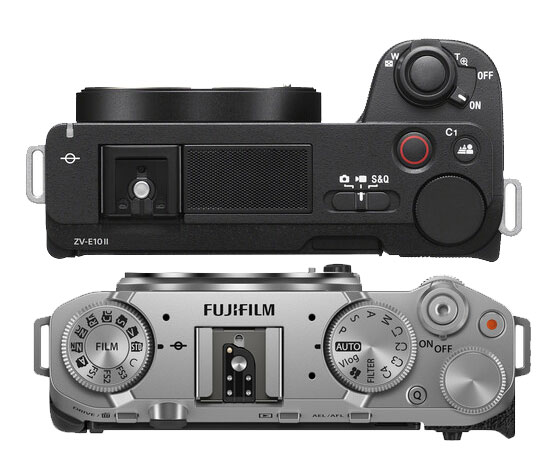
For Photographers
You can buy any one you like since both of them missing EVF and feature the same resolution sensor, but the Sony ZV-E10 offers a better handgrip whereas the Fuji X-M5 is more vlogging-oriented, without a doubt the Sony ZV-E10 II AF tracking performance is better so you can consider that also, on the other side we have film-simulation modes from Fuji which is being loved by many photographers worldwide.
Fuji X-M5 Price
Fujifilm X-M5 Body: $799- B&H Store
Fujifilm X-M5 + XC 15-45 Kit: $799 – B&H Store
Sony ZV-E10 Price
Sony ZV-E10 Mark II $998 [body]- B&H Store – [$1098 with kit at Amazon] Amazon.com
Support us – Use an affiliate link Amazon.com | B&H Store for the next purchase u make – it helps us
Admin Notes: Comparison Updated on – October 2024
Correction log: Updated recording time limit of the Fuji X-M5
By admin, on August 10th, 2024
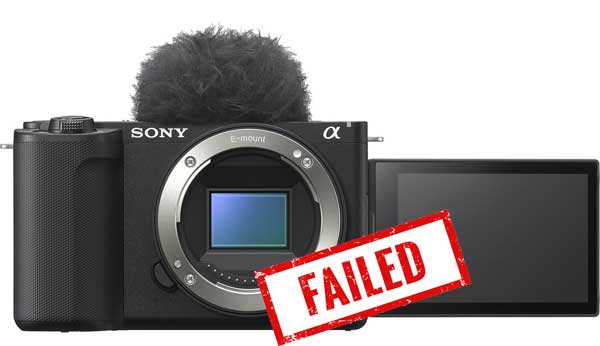
According to Chinese source E88_888 (translated) the ZV-E10 Mark II camera sale is not going well in the USA and their successful strategy of creating a Highly popular Vlogging camera is halted or you can say it has failed this time to impress the consumer base, and means that ZV series lost its effectiveness to impress the consumer base out there.
The ZV-E10 Mark II camera’s price is somewhat close to the Sony A6700 camera, but it lacks the AI processing unit as well as sensor-shift image stabilization. Additionally, it doesn’t support the video frame rates available in the A6700 camera. Sony has crippled many of the specifications inside the ZV-E10 Mark II camera to protect the sales of the A6700 camera. At the same time, due to its high price tag, the camera was not able to directly replace its predecessor, the ZV-E10, whose sales are still going well.
It looks like Sony’s strategies have failed this time to read out the actual requirements of consumers out there.
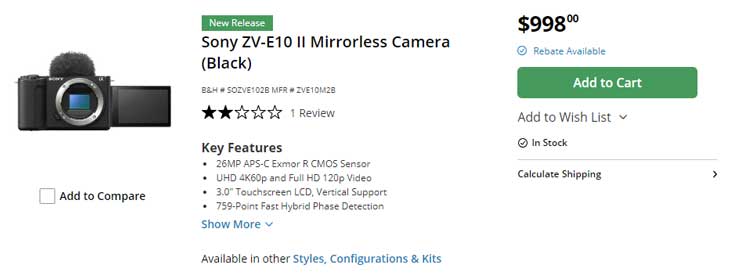
Follow us on our social pages FACEBOOK | TWITTER | INSTAGRAM, If you have time –>see more Sony Alpha Rumor
source E88_8888
By admin, on July 4th, 2024
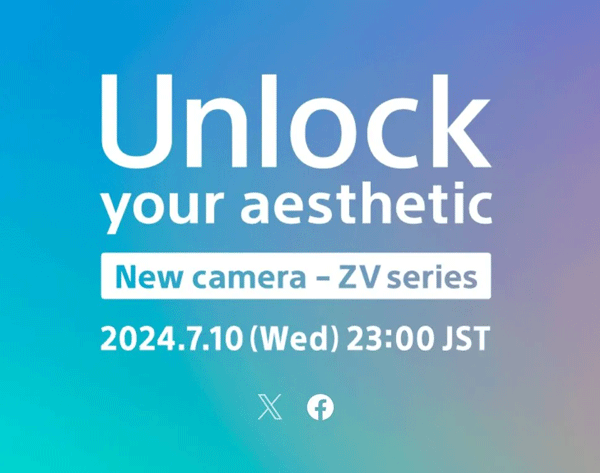
Sony ZV-E10 Mark II camera teaser was posted by Sony itself on their creator app (or maybe accidentally leaked). Still, the creator app was displaying an image that the camera was coming on July 10, 2024. You can also see the screenshot of the mentioned items where the ZV-E10 Mark II is very clearly listed.
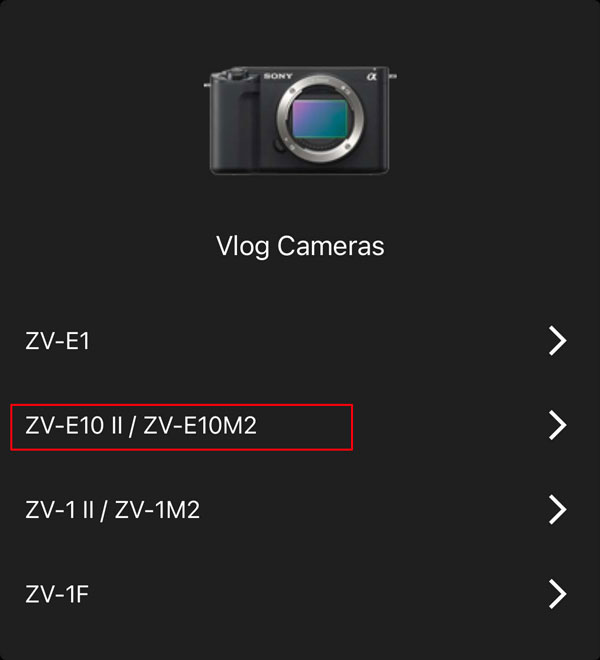
So now you are a hundred percent confirmed that the ZV-E10 Mark II camera is coming on July 10. We also have the rumored set of specifications of the upcoming camera. Take a look at the specs below and the expected pricing of the camera.
- 26MP Exmor R APS-C BSI CMOS Sensor
- BIONZ XR Image Processor
- Dedicated AI Chip / AI Auto framing and advanced AF modes
- UHD 4K 120p [crop] 4K 60p Uncropped / FHD 240p / 10-Bit 4:2:2
- Up to 11-fps Shooting, ISO 100-32000
- Real-Time Tracking AF for Stills & Video
- 759-Point Phase Detection, 93% Coverage
- S-Log3, S-Gamut3, S-Cinetone, User LUTs
- NO EVF – Same Body Desing as ZV-E10
- Internal Mic + Inputs, USB Streaming
- FZ100 Battery | Slightly deeper handgrip then of ZV-E10
- 3″ 1.03m-Dot Vari-Angle LCD Touchscreen
Follow us on our social pages FACEBOOK | TWITTER | INSTAGRAM, If you have time –>see more Camera News and Sony Alpha Rumor
By admin, on June 24th, 2024
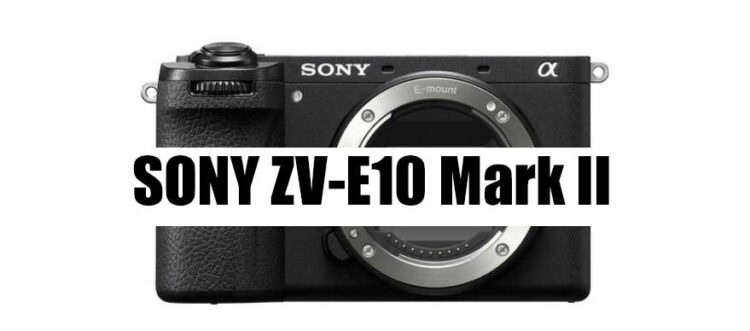
We have told you guys, the ZV-E10 II is coming on JULY and now We have confirmation. According to the latest rumors, the Sony ZE-10 II camera is expected to be announced on July 10, 2024, we have already discussed the Core specification of the camera and the possible price range you can see here.
— End of Rumor —-
Source of data of announcement – SAR YT Channel
The camera specification is expected to remain the same as we told you a few months ago.
- 26MP Exmor R APS-C BSI CMOS Sensor
- BIONZ XR Image Processor
- Dedicated AI Chip / AI Auto framing and advanced AF modes
- UHD 4K 120p [crop] 4K 60p Uncropped / FHD 240p / 10-Bit 4:2:2
- Up to 11-fps Shooting, ISO 100-32000
- Real-Time Tracking AF for Stills & Video
- 759-Point Phase Detection, 93% Coverage
- S-Log3, S-Gamut3, S-Cinetone, User LUTs
- NO EVF – Same Body Desing as ZV-E10
- Internal Mic + Inputs, USB Streaming
- 3″ 1.03m-Dot Vari-Angle LCD Touchscreen
Price Sony ZV-E10 [Rumored Price approx]
- Price $798 [Bodly Only] | $899 With 16-50mm Lens | $1199 Creator Kit (Wireless grip + Shotgun Mic) | $1399 with 10-20mm Lens
Follow us on our social pages FACEBOOK | TWITTER | INSTAGRAM, If you have time –>see more Camera News and Sony Alpha Rumor
By admin, on June 23rd, 2024
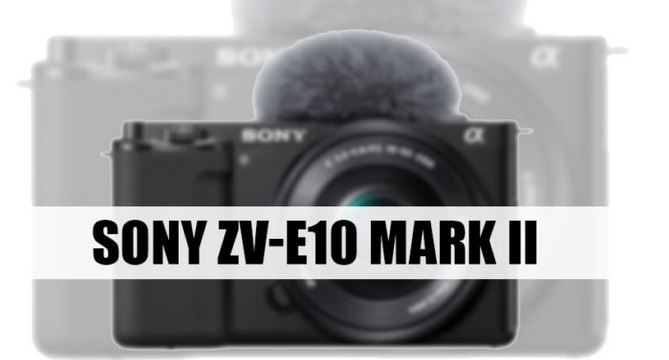
We are the only website that told you Sony ZV-E10 II is Coming in July 2024. Check our post published back on June 14. So, the good news is the camera is coming and I am super excited, take a look at the rumored specifications of the upcoming camera
Our June 14 post, We have written
According to the latest tip, Sony is gearing up for an Camera announcement in July Month, ready to send NDA to the press and samples for creating content, before they make the official announcement. The source told us, “The most awaited Sony camera is set to come next month. Press kits are prepared, and NDA forms will be sent to press members and reviewers shortly” So, we are expecting the announcement Sony ZV-E10 Mark II next month.
Since, Expecting a Sony A7V announcement next month isn’t that logical, as well as any other Sony mirrorless camera for now.
- 26MP Exmor R APS-C BSI CMOS Sensor
- BIONZ XR Image Processor
- Dedicated AI Chip / AI Auto framing and advanced AF modes
- UHD 4K 120p [crop] 4K 60p Uncropped / FHD 240p / 10-Bit 4:2:2
- Up to 11-fps Shooting, ISO 100-32000
- Real-Time Tracking AF for Stills & Video
- 759-Point Phase Detection, 93% Coverage
- S-Log3, S-Gamut3, S-Cinetone, User LUTs
- NO EVF – Same Body Desing as ZV-E10
- Internal Mic + Inputs, USB Streaming
- 3″ 1.03m-Dot Vari-Angle LCD Touchscreen
Price Sony ZV-E10 [Rumored Price approx]
- Price $798 [Bodly Only] | $899 With 16-50mm Lens | $1199 Creator Kit (Wireless grip + Shotgun Mic) | $1399 with 10-20mm Lens
A word from TNC to all website editors – Many people might copy our content without giving us credit, as it’s in their nature. If you wish to republish our material, please ensure to provide a credit link back to us.
What else we are also expecting –
Sony A7 V is set to be released in Q4 of 2024 is everything goes on schedule, the camera will have an uploadable LUT option, a dedicated AI chip for AI Auto framing, and an upscaled AF performance, the user will notice a Major upscaling in the Video performance of the camera.
Follow us on our social pages FACEBOOK | TWITTER | INSTAGRAM, If you have time –>see more Camera News and Sony Alpha Rumor
By admin, on June 14th, 2024

According to the latest tip, Sony is gearing up for an Camera announcement in July Month, ready to send NDA to the press and samples for creating content, before they make the official announcement. The source told us, “The most awaited Sony camera is set to come next month. Press kits are prepared, and NDA forms will be sent to press members and reviewers shortly” So, we are expecting the announcement Sony ZV-E10 Mark II next month.
Since, Expecting a Sony A7V announcement next month isn’t that logical, as well as any other Sony mirrorless camera for now.
source is new so take it with grain of salt.
Follow us on our social pages FACEBOOK | TWITTER | INSTAGRAM, If you have time –>see more Camera News and Sony Alpha Rumor
|
KEEP THIS BLOG ALIVE - Support New Camera Buy Canon Lenses, Buy Music CD or Digital Camera at amazon it helps this site, and you do not pay anything extra, it is just a way to help support this site.

|





















